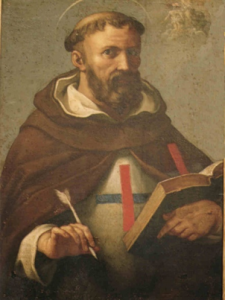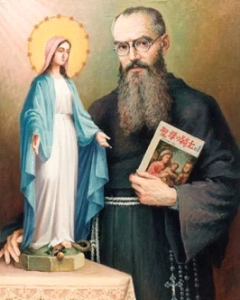 Saint John of Matha
Saint John of Matha
Founder (1160-1213)
Feast – February 8
On April 22, 571 AD in Mecca, Saudi Arabia Abū al-Qāsim Muḥammad ibn ʿAbd Allāh ibn ʿAbd al-Muṭṭalib ibn Hāshim, an Arab religious, social, and political leader and the founder of Islam was born, a prophet, sent to present and confirm the monotheistic teachings preached previously by Adam, Abraham, Moses, Jesus, and other prophets.
The Muslim community spread through the Middle East through military conquest, inspired by religion and motivated by greed and politics.
Between the eighth and the fifteenth centuries medieval Europe was in a state of intermittent warfare between the Christian kingdoms of southern Europe and the Muslim polities of North Africa, Southern France, Sicily and portions of Spain. Raids by Muslim bands and armies were an almost annual occurrence. The threat of capture or kidnapping, whether by Muslim pirates or coastal raiders, or during one of the region’s intermittent wars, was a continual concern for residents of Catalonia, Languedoc, and other coastal provinces of medieval Christian Europe.
In 1160 St. John of Matha, the institutor of the Order of the Most Holy Trinity for the Ransom of Captives, was born at Faucon in Provence, France, to parents, Euphemius and Martha at Faucon-de-Barcelonnette. They were conspicuous for their nobility and virtue, and St John was consecrated to God by a vow at his birth.
His life from his youth was exemplary, by his self-sacrifice for the glory of God and the good of his neighbor. As a child, his chief pleasure was serving the poor; and he would say to them that he had come into the world for no other end but to care for them.
His father Euphemius sent him to Aix, where he learned grammar, fencing, riding, and other exercises fit for a young nobleman. While there he gave the poor a considerable part of the money his parents sent him, and he visited the hospital every Friday to assist the sick poor.
Later he studied in Paris with such distinction that after having completed his theological course, he received the degree of doctor. His eminent learning and virtue induced the Bishop of Paris to promote him, in spite of his humble resistance, to the Holy Order of Priesthood, in the hope that during his sojourn in that city, he might be a bright example to young students by his talents and piety. At the age of 32 in December 1192 St. John of Matha was ordained a priest.
While celebrating his first Mass in the Bishop’s chapel, in the presence of the Prelate and several assistants, he was honored by a signal of favor from Heaven. There appeared to him an Angel clad in a white and brilliant robe; he had on his breast a red and blue cross, and his hands reposed on the heads of a Christian and a Moorish captive.
To comprehend what this vision might signify he thought it wise to spend some time in retirement, prayer, and mortification. Having heard of a holy hermit, St. Felix of Valois, living in a great wood near Gandelu, in the diocese of Meux, he requested him for instructions in the practice of perfection. They agreed to live together, and for three years St. John devoted himself to prayer and contemplation.
Another sign was given the two hermits. It happened, that as they were one day seated near a fountain, conferring with each other on holy things, a stag came towards them, bearing a red and blue cross between his antlers. St. John, perceiving that St. Felix was surprised by so strange an occurrence, told him of the vision he had had at his first Mass. They gave themselves even more fervently to prayer, and having been admonished in sleep, they resolved to set out for Rome in the midst of a severe winter, towards the end of the year 1197, to learn the Will of God from the lips of the Sovereign Pontiff. Pope Innocent III consulted the Sacred College and had a Mass offered in the Lateran basilica, on the feast of St. Agnes, to understand what God was asking. At the moment of the Elevation, the Pope saw the same Angel in the same vision as had been given St. John.
On December 17, 1198, the Pontiff gave his approbation to the new institute, and commanded it to be called the Order of the Most Holy Trinity for the Ransom of Captives, bidding its members wear a white habit, with a red and blue cross. Fully approved in 1209, they erected their first monastery at Cerfroid, in the diocese of Meaux. Pope Innocent III gave them the house, church, and hospital of St. Thomas de Formis, together with various revenues and possessions.
Soon, countless vocations came to the Order. The members of the Order fasted every day, and after preaching throughout Europe, winning associates for their Order and gathering alms to buy back captives, went to northern Africa to redeem the Christian slaves taken prisoner during the Crusades or while traveling on the seas. The first Christian slaves were rescued by the Order in 1201. To carry out this task, the Trinitarians needed large amounts of money. So, they placed their fund-raising efforts under the patronage of Mary, the Mother of God. In gratitude for her assistance, St. John of Matha honored Mary with the title of “Our Lady of Good Remedy.”
The main goal of the Trinitarians, which was to ransom the captives, also had a favorable effect on the Crusaders, who had less fear to be captured and remain slaves of the Moors for a long period of time, or even indefinitely. The Trinitarians traveled with the Crusaders, teaching the soldiers, taking care of the sick, and dealing with the redemption of the captives and gave them the hope to be ransomed and return to the fight.
In 1202 and 1210 St. John travelled to Tunis himself and brought back countless Christian slaves.
On his second trip in 1210, he suffered much from the infidels, who were enraged at his zeal and his success in exhorting the slaves to remain constant in their faith. On his return with the 120 Catholics whom he had ransomed, he found that the Muslims had damaged the rudder of his ship and ripped its sails to prevent its safe arrival and cause the ship to perish at sea. Instead, St. John of Matha, full of confidence in God, begged Him to be their pilot. He tied his cloak to the mast, with a crucifix in his hands, saying, “Let God arise, and let His enemies be scattered! O Lord, Thou wilt save the humble, and wilt bring down the eyes of the proud.” Wind filled the small sail, and a few days later brought the ship safely to the port of Ostia, near the mouth of the Tiber, three hundred leagues from Tunis.
Saint John on one occasion was assaulted in Morocco and left, in his blood, for dead. He was preserved by a miracle and took up his charitable services again.
Worn out by his heroic labors, John died in 1213, at the age of fifty-three.
References and Excerpts:
[1] “Saint John of Matha, Founder.” [Online]. Available: https://sanctoral.com/en/saints/saint_john_of_matha.html. [Accessed: 06-Feb-2020].
[2] “St. John of Matha, saint of February 8.” [Online]. Available: https://www.traditioninaction.org/SOD/j114sdJohnMatha_2-08.htm. [Accessed: 06-Feb-2020].
[3] “St. John of Matha.” [Online]. Available: https://www.salvemariaregina.info/SalveMariaRegina/SMR-167/Matha.htm. [Accessed: 06-Feb-2020].
[4] “John of Matha,” Wikipedia. 06-Feb-2020.
 Consequently, Pilate tried to release him; but the Jews cried out, “If you release him, you are not a Friend of Caesar. Everyone who makes himself a king opposes Caesar.” When Pilate heard these words he brought Jesus out and seated him on the judge’s bench in the place called Stone Pavement, in Hebrew, Gabbatha. It was preparation day for Passover, and it was about noon. And he said to the Jews, “Behold, your king!” They cried out, “Take him away, take him away! Crucify him!” Pilate said to them, “Shall I crucify your king?” The chief priests answered, “We have no king but Caesar.” (John 19:12-15)
Consequently, Pilate tried to release him; but the Jews cried out, “If you release him, you are not a Friend of Caesar. Everyone who makes himself a king opposes Caesar.” When Pilate heard these words he brought Jesus out and seated him on the judge’s bench in the place called Stone Pavement, in Hebrew, Gabbatha. It was preparation day for Passover, and it was about noon. And he said to the Jews, “Behold, your king!” They cried out, “Take him away, take him away! Crucify him!” Pilate said to them, “Shall I crucify your king?” The chief priests answered, “We have no king but Caesar.” (John 19:12-15) St. Maximilian Kolbe during his time as a student in Rome witnessed the violent demonstrations of Freemasons under the windows of the Vatican showing an image of the archangel, St. Michael lying under the feet of the triumphant Lucifer. As a response on October 16, 1917 with six other friars he founded the Militia Immaculata (Army of the Immaculate One) with the aim of converting sinners, enemies of the Catholic Church, heretics and schismatics, particularly freemasons, through the intercession of the Virgin Mary. To accomplice this task he began to publish The Knight of the Immaculate to “illuminate the truth and show the true way to happiness.”
St. Maximilian Kolbe during his time as a student in Rome witnessed the violent demonstrations of Freemasons under the windows of the Vatican showing an image of the archangel, St. Michael lying under the feet of the triumphant Lucifer. As a response on October 16, 1917 with six other friars he founded the Militia Immaculata (Army of the Immaculate One) with the aim of converting sinners, enemies of the Catholic Church, heretics and schismatics, particularly freemasons, through the intercession of the Virgin Mary. To accomplice this task he began to publish The Knight of the Immaculate to “illuminate the truth and show the true way to happiness.”